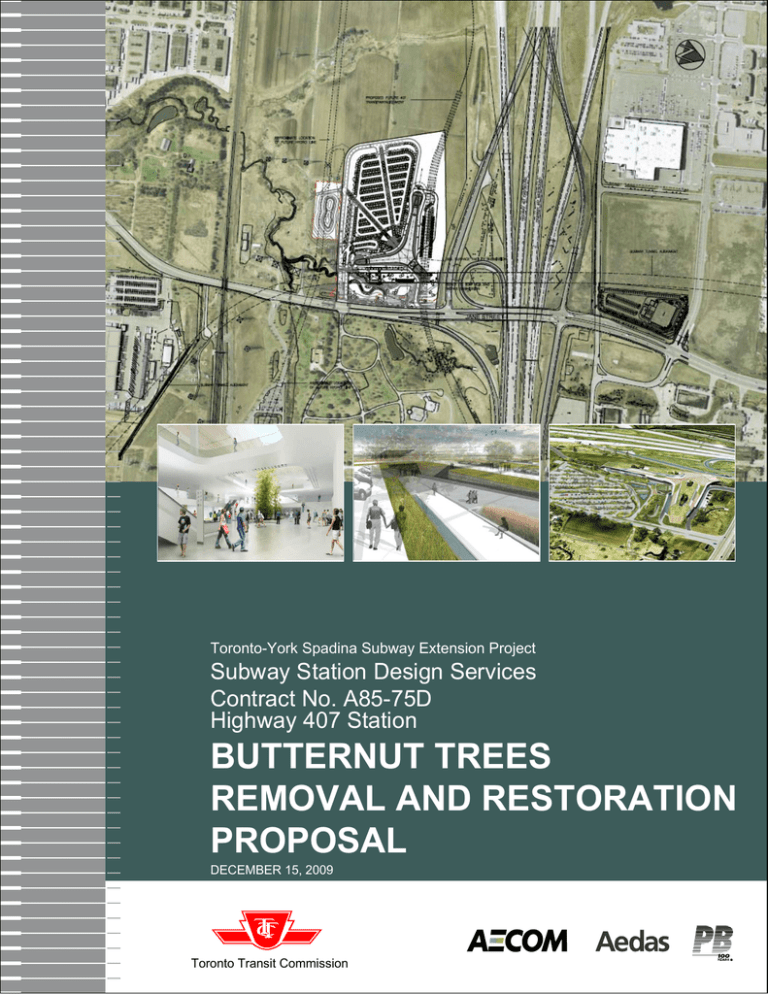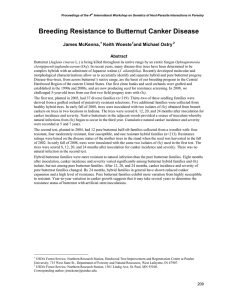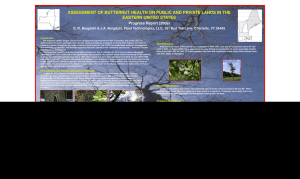BUTTERNUT TREES REMOVAL AND RESTORATION PROPOSAL Subway Station Design Services
advertisement

Toronto-York Spadina Subway Extension Project Subway Station Design Services Contract No. A85-75D Highway 407 Station BUTTERNUT TREES REMOVAL AND RESTORATION PROPOSAL DECEMBER 15, 2009 Toronto Transit Commission Background This report describes the existing ecological setting in which the presence of provincially endangered Butternut trees (Juglans cinerea) have been identified at the proposed Highway 407 Station of the Toronto York Spadina Subway Extension Project. A detailed description of the TYSSE project is provided for review in Appendix A. It further examines the specific characteristics of the identified Butternut trees and provides health assessments for these trees, including the appropriate determination regarding if the trees were retainable. The Toronto Transit Commission is submitting this report to the Ministry of Natural Resources for their review under their Authority for the Endangered Species Act (2007) and the subsequent issuance of a permit for the removal of the Butternut trees identified at the Highway 407 Station. 1. Natural Environment at the Highway 407 Station The Highway 407 Station is located within Lots 2 and 3, Concession 5 in the City of Vaughan, York Region, Province of Ontario. The dominant natural feature associated with this site is the Black Creek valley land and Black Creek. Black Creek is a tributary of the Humber River. The Black Creek valley is located in a predominantly mixed urban-agricultural landscape. The natural valley lands comprise a less than 20% of the study area, the remaining lands consist of active agricultural fields and associated infrastructure. The valley is bordered by the 407 ETR to the north and Jane Street to the east. The west side of the valley lies adjacent to agricultural lands The southern extent of the valley extends into a Hydro One utility easement and terminates at the CN Rail line. The existing vegetation within the valley is largely a result of anthropogenic disturbances. The site contains a high proportion of non-native species compared with surrounding areas, with 42% of the 57 plant species identified within the valley being non-native to Ontario. Native and non-native species are intermixed within ‘cultural’ communities that are likewise maintained by human activities. The cultural communities of study area are typically young to mid-aged cultural meadows, cultural woodlands, cultural thickets and cultural hedgerows. There are no forest communities within the study area. According to the Natural Heritage Information Centre none of the communities identified at the Highway 407 location are significant or rare within the province of Ontario. Species significance was evaluated against national, provincial and regional criteria. National (COSEWIC) and Provincial (COSSARO) rankings were consistent with those posted on the Natural Heritage Information Centre (NHIC) database. Provincially rare species were those ranked as S1-S3 by NHIC. Regional significance was based on rarity rankings assigned in Site District 7E4 by Varga et al. (2000). Based on these criteria, one provincially endangered species (Butternut, Juglans cinerea) and one regionally rare species (Black walnut, Juglans nigra) occur within Highway 407 Station study lands. 2. Description of the Butternut Features and Health Assessment Two Butternut trees and one sapling were identified during field surveys completed by AECOM during the summer of 2009. All occur within 10 m of each other on the west slope of the Black Creek valley lands in relatively poor drained clay loam soil at the toe of bank. The largest tree has a diameter at breast height of 20 cm, a well defined canopy and was bearing seeds when identified (Plates 1 and 2). Seed sets associated with this tree were typically 3-5 nuts; however this tree did contain at least 2 clusters having 6 nuts (Plate 3). A sapling measuring 0.5 m in height was identified within 3 m of this tree. A third Butternut tree with a triple stem and diameter at breast height of 14 cm was identified within 10 m of the first tree (Plate 4). This tree did not have any seeds at the time of identification. Appropriate documentation of the physical description of the trees, as well as the Butternut Health Assessments and the Butternut Retainable Tree Analysis are provided in Appendix B. Plate 1. AECOM ecologist beside 20 cm DBH Plate 2. Canopy of the 20 cm DBH tree Butternut tree Plate 3. Seed set from 20 cm DBH tree Plate 4. AECOM ecologist beside 14 cm showing 6 nuts within a single grouping DBH triple stemmed Butternut tree A health assessment was performed by James Kamstra of AECOM’s Markham office. All three specimens were determined to be healthy with no signs of dieback or chancre (BHA forms provided in Appendix A). The presence of seed sets containing 6 nuts required further examination to determine if the trees were hybrid forms of Butternut. Subsequent examinations by AECOM and the MNR District Forester Bohdan Kowalyk, are in agreement that the trees are a genetically pure form of Juglans cinerea. The location of the trees is with respect to the study area is shown in below. 3. Impact Statement The TYSSE project requires the removal of the three Butternut trees for the construction of the Highway 407 Station. The TYSSE project has undergone several environmental assessments, including • City of Toronto and TTC’s Spadina Subway Extension Environmental Assessment from Downsview Station to Steeles Avenue (February 2006); • York Region Highway 7 Corridor Vaughan North-South Link Public Transit Improvements Environmental Assessment (August 2005); • York Region Response to Conditions of Approval – Vaughan N-S Link Subway Alignment Optimization Report.(June 2007);(COA Report) and; • CEAA Environmental Screening Report - Toronto–York Spadina Subway Extension, – Downsview Station to the Vaughan Corporate Centre Station (March 2008). However, the impacts of the project on Butternut trees at the Highway 407 Station were not addressed in these reports since the trees were previously unidentified within the project area. In consideration of this, the TTC is seeking a permit from the MNR for the removal of the trees and recognizes the need to provide suitable compensation to reflect a net benefit to Juglans cinerea within the local geographic area and the province as a whole. 4. Mitigation and Compensation Opportunities 4.1 Mitigation Mitigation through the realignment of the subway is not feasible as this would require a significant redesign of a portion of the approved subway system design. This redesign would negatively impact the construction schedule and add significant additional costs to the project. Redesign at a local scale is likewise not possible since the Highway 407 Station and associated subway alignment within the study area is constrained by Black Creek and Jane Street to the east and an existing Hydro One 500kV turning tower (Tower 158) and transmission line to the south west. Given these constraints, there is insufficient available to relocate the subway and avoid impacts to the Butternut trees. Consequently, the TYSSE is proposing to address the loss of the three Butternut trees through direct compensation. 4.2 Compensation for Butternut Tree Removal In accordance with the Endangered Species Act (2007), and through discussions with MNR District Forester (Bohdan Kowalyk) compensation requires the replanting of Butternut in the following ratios: • • • 20:1 for trees 20 cm dbh or greater (plus companion plantings) 10:1 for trees 10 cm to 20 cm dbh (plus companion plantings) 2:1 for trees 10 cm dbh or smaller (plus companion plantings) In addition, companion plantings are also required to provide suitable protection for the replanted Butternut. Based on these criteria, direct compensation for removing the three Butternut trees from the Highway 407 Station site will be a need to replant 32 Butternut trees plus required companion plantings. Through discussions the MNR District Forester it was noted that it is preferable to provide compensation for removed Butternut trees as close to the original location as possible. Subsequently, AECOM has identified available restoration areas for Butternut within the project footprint and included these in the overall site restoration plan for the Highway 407 Station (Drawing A40-13-L1001). The intent was to select areas that have a similar location within the Black Creek valley and that are as close to the original tree locations as permissible. The specified areas will require further assessment with respect to soils, drainage and location (proximity to roadways) in order to further refine optimum locations for Butternut replanting. Based on the available area and limited number of replanted trees it appears possible to provide complete compensation for Butternut removals on site. At this stage, the location, density and planting plan for Butternut tree replacements is provided for discussion and input from the MNR District Forester is viewed as a critical component in the development of the final compensation plan. The proposed nursery stock for compensation must be genetic pure strain Butternut. The Forest Gene Conservation Association Butternut Recovery Program has Butternut trees of local origin available for replanting in 2010. Discussions with the program coordinator (Barb Boyson) to discuss the availability of Butternut trees from this program for restoration at the Highway 407 Station site are forthcoming. Because these Butternut trees were grown from scions collected from trees removed from lands east of Jane Street, within 5 km of the 407 Station site, they are of extreme interest to the TTC as compensation plantings. Of equal importance to the TTC is the potential to use trees grown from the 91 nuts collected by AECOM (on behalf of the TTC) from the Butternut tree located on the Highway 407 Station site. These nuts were provided to Madelaine Danby of the Midhurst MNR office for use in the MNR stewardship initiative. If suitable trees were available from the planting of these seeds, the TTC would be interested in using this stock for replanting purposes. Another option is for trees to be grown from scions taken from the existing Butternut at the Highway 407 Station location. The TTC would not undertake this activity directly but will explore options with the Forest Gene Conservation Association and MNR in this regard. Given the timing of the overall station construction (2010-2014) it may be possible to grow trees suitable for compensation from this source of local stock. 5. Monitoring and Stewardship Commitment In addition to the direct compensation requirements, the requirement for 5 years of post planting monitoring will be addressed in the development of the overall compensation plan. The TTC is considering opportunities to work with local groups, such as the MNR, Forest Gene Project and Toronto and Region Conservation Authority to develop a stewardship approach to ensure that the compensation plan and subsequent survivorship of replanted Butternut meets the overall objectives intended for this site and conditions outlined by the MNR in the permitting for this project under the ESA. 6. Summary and Conclusions The TYSSE project is a significant an important infrastructure project for the Province of Ontario. The approved environmental assessments for this project have determined a subway alignment that requires the removal of three Butternut trees at the Highway 407 Station. Mitigation through design/redesign has been determined to be un-feasible and the trees must be removed. A preliminary compensation plan has been provided for MNR review. Moving forward, the TTC will continue to seek the input and advice of the MNR in the design and implementation of a suitable compensation plan in support of a permit to remove the Butternut from the Highway 407 Station site and fulfill the Ministry’s mandate for the protection of endangered Juglans cinerea within the Province of Ontario. Appendix A Detailed Project Description Project Description This project is referred to as the Toronto-York Spadina Subway Extension (TYSSE) from Downsview Station to the Vaughan Corporate Centre Station. This project is comprised of the recommended subway extension outlined in the City of Toronto and TTC’s Spadina Subway Extension Environmental Assessment from Downsview Station to Steeles Avenue, and the extension of the Spadina Subway that was included as part of York Region’s Highway 7 Corridor Vaughan North-South Link Public Transit Improvements Environmental Assessment, and York Region’s June 2007 Response to Conditions of Approval – Vaughan N-S Link Subway Alignment Optimization Report. The recommended alignment of the subway extension starts at Dufferin Street north of Sheppard Avenue and curves west to pass through Downsview Park. The alignment then crosses below the CN Newmarket Subdivision and curves north along Keele Street, and swings westerly through York University. The north-west oriented alignment then crosses under Steeles Avenue and follows a northwesterly direction across the northeastern corner of the UPS property. The alignment then traverses the Hydro One corridor and swings north under the CN Rail Halton Subdivision tracks, Jane Street and Black Creek. Immediately after crossing Black Creek, the subway connects to the Highway 407 Station and then continues north under the 407 Express Toll Route (ETR) and aligns with the easement negotiated by the City of Vaughan with the property owners north of Peelar Road (north of Highway 407). On this tangent stretch, the Vaughan Corporate Centre (VCC) Station is located where the subway alignment crosses Highway 7. Proposed Toronto York Spadina Subway Extension alignment plan. Project Need and Justification The City of Toronto’s Official Plan (TOP) (brought into effect by an order of the Ontario Municipal Board in July, 2006) estimates that Toronto will grow by 540,000 residents and 544,000 employees between 1996 and 2031. The TOP makes provision for only limited expansions to Toronto’s major road system. Instead, the Plan places considerable emphasis on providing new and improved public transit services to help direct future population and employment growth into a more sustainable urban form. The TOP is based on a fundamental objective of reducing dependence on the private automobile. One major way to reduce car use is to increase the competitiveness of other, more environmentally friendly and economically efficient means of transportation, such as public transit, cycling, and walking. It is also important for Toronto to encourage transit-supportive development in the vicinity of rapid transit stations and along selected high frequency transit routes. The TOP directs development to targeted mixed-growth areas that are well served by transit, principally the Downtown, Centres and Avenues. These designated growth areas provide opportunities for re-urbanization and reinvestment in municipal infrastructure, along with better use of existing transportation infrastructure. Similarly, York Region, with its rapid growth has an Official Plan that recognizes the importance of public transit as a core component to its transportation network to support a sustainable urban structure and the economic viability of the Region. The Regional Official Plan (ROP) enshrines an urban structure which is highly dependent on transit infrastructure, premised on a network of Regional Centres linked along Regional corridors served by rapid transit. York Region has been one of the fastest growing regions in the GTA and growth is anticipated to continue. As the population of York Region has grown, so have the traffic volumes on Regional roads. Efficient movement of people and goods is vital to the economic health of York Region, and the Region is focused on minimizing traffic congestion through the provision of effective transit services, ensuring an adequate Regional road network and undertaking transportation demand initiatives. With declining vehicle occupancy rates, increased road congestion, and diminishing air quality in the GTA, the need for improvements to public transit is becoming increasingly critical. In order to support the anticipated growth in travel demand across the GTA over the next 30 years, strengthened inter-regional transit services are essential to better link key urban growth centres and provide the necessary infrastructure to support transit-oriented development. A key piece of transit infrastructure that has been identified by Ontario, Toronto and York Region is the Toronto–York Spadina Subway Extension. The Toronto–York Spadina Subway Extension is needed to help in reducing the reliance on automobiles, reduce vehicle emissions and to increase the overall person carrying capacity of the north-south transportation system that provides an essential interregional connection between the City of Toronto and York Region. The Toronto-York Spadina Subway Extension will assist in creating employment opportunities and new residential and commercial development within the City of Toronto and York Region. The extension will aid in protecting and enhance the social and natural environments along with promoting smart growth and economic development in the corridor. Appendix B Butternut Health Assessment and Retainable Tree Analysis Forms LC % 100 90 100 Tree # 1 2 3 Live Crown % 0.5 14 20.5 dbh (cm) # bole cankers 0 0 0 S <2m 0 0 0 S >2m 0 0 0 O <2m Total # trees total bole & root canker % of 2xCirc 0 0 0 O >2m 0 0 0 RF sooty 0 0 0 RF open # root flare (RF) cankers Circ. (cm) = Pi x dbh 1.57 44 64.4 Circ (cm) 0 0 0 BC (cm) 0 0 0 RC (cm) total bole canker width (sooty x 2.5 + open x 5) total root flare canker width (sooty x 2.5 + openx5) 0 0 0 BC% 0 0 0 RC% 0 0 0 BRC% automatic calculations from field data 3 r r r 1 r r r 2 r r r 3 R scenarios Retainable R=yes or N=no Jane Street south of Highway 407 ETR, Lots 2 and 3, Concession 5 bole canker % of circ. input field data sooty (S) (will be assigned 2.5 cm per canker) Toronto Transit Commission root flare canker % of circ. City of Vaughan open (O)(will be assigned 5 cm per canker) July 28 2009 LC%>/= 50 and BC% = 0 Ontario Realty Corporation tree dbh (cm) Assessment Date(s) LC%>70 & BRC%<20 even if BC% > 20 BHA #34 3 get exp. crown assess.) ESA 2007 analysis method: LC% > 70 & BC%< 20,even if RC%> 20 (or Contact the OMNR Provincial SAR Unit for a more detailed explanation of its derivation (June 2009). Butternut Retainable Tree Analysis (using data collected by a designated BHA (ESA 2007)) R R R R/N Final Call





